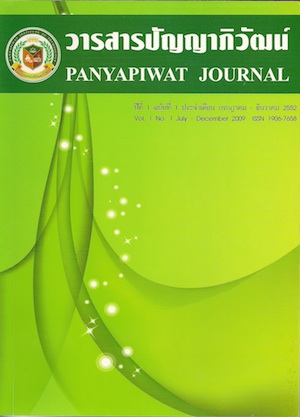Writing Punchlines for Jokes
Main Article Content
บทคัดย่อ
บทคัดย่อ
งานวิจัยนี้มีวัตถุประสงค์เพื่อทราบถึงวิธีการเของนักศึกษาของมหาวิทยาลัยเทคโนโลยีพระจอมเกล้าธนบุรีขียนจุดหักมุมของเรื่องขำขัน เพื่อเป็นประโยนช์ต่อครูอาจารย์ที่จะนำเรื่องขำขันไปใช้สอนในห้องเรียนภาษา เรื่องขำขันที่ใช้ในงานวิจัยนี้ได้ถูกคัดเลือกจากอินเตอร์เนตโดยเป็นไปตามมาตรฐานในการคัดสรรค์ คือ ความยาวของเรื่องขำขัน บริบทของเรื่องขำขัน ความยากของภาษา และต้องมีสถานการณ์ที่หลากหลาย สำหรับกลุ่มตัวอย่างที่ใช้ในงานวิจัยนี้คือนักศึกษาคณะวิศวกรรมศาสตร์ สาขา เครื่องมือและวัสดุและวิศวกรรมไฟฟ้าของมหาวิทยาลัยเทคโนโลยีพระจอมเกล้าธนบุรีจำนวน 8 คน ในการเขียนจุดหักมุมของเรื่องขำขันนี้กลุ่มตัวอย่างจะพบกับปัญหา คือ ความยาวของเรื่องขำขัน ความไม่คุ้นเคยกับเรื่องขำขัน ความยากของภาษา และ การขาดความคิดในเชิงสร้างสรรค์ กลุ่มตัวอย่างในงานวิจัยนี้จะต้องเขียนจุดหักมุมของเรื่องขำขันทั้งหมดสิบห้าเรื่องด้วยกันโดยเรื่องขำขันนั้นจะแบ่งออกเป็นครั้งละสามชุดดังนั้นกลุ่มตัวอย่างจะต้องใช้เวลาทั้งหมดห้าวันเพื่อเขียนจุดหักมุมของเรื่องขำขันนั้นให้ครบห้าชุด หลังจากนั้นผู้วิจัยจะนำจุดหักมุมของเรื่องขำขันดังกล่าวส่งมอบให้ผู้ประเมินเพื่อดูคุณภาพการเขียนโดยเป็นไปตามมาตรฐานคือ ความต่อเนื่องของเรื่องราว การสื่อสารความเข้าใจ ความคิดสร้างสรรค์ และ สนุก ในงานวิจัยนี้ผู้ทำการวิจัยจะพบว่ากลุ่มตัวอย่างมีปัญหาในการเขียนจุดหักมุมของเรื่องขำขันและวิธีการแก้ไขปัญหาซึ่งจะเป็นประโยชน์ในการใช้สอนภาษาและการฝึกการเขียนให้กับนักเรียนนักศึกษาต่อไป
คำสำคัญ : เรื่องขำขัน, อารมณ์ขัน, จุดหักมุมของเรื่องขำขัน, กระบวนการการเขียน, ความยากและการจัดการในการเขียนจุดหักมุม, ความคิดสร้างสรรค์
Abstract
This study intends to investigate how students manage difficulties in order to write punchlines for jokes. It is beneficial for ESL teachers who like to use jokes in language classroom. The jokes in this study were selected from the Internet according to certain criteria concerning the length of jokes, joke contexts, language complexity, variety of topics and situations. The subjects of this study were eight students from the Department of Material and Tool Engineering and the Department of Electrical Engineering at King Mongkut’s University of Technology Thonburi (KMUTT). In writing punchlines, the subjects had difficulties cause by inappropriate length of jokes, unfamiliarity with jokes, insufficient language ability and lack of creative ideas. Then, they used their techniques to cope with the difficulties. To the techniques, subjects’ punchlines were evaluated by three raters ranging from the best to the worst punchlines.
The subjects were required to write punchlines for provided fifteen jokes. They were asked to spend three days a week and write three punchlines a day. When they finished each three jokes, the subjects were interviewed how they wrote their own punchlines. To write punchlines, it is found that the subjects had difficulties caused by inappropriate length of jokes, unfamiliarity with jokes, insufficient language ability and lack of creative idea in writing. However, they had their techniques to manage difficulties by using re-reading, connecting jokes with their own experiences, imagining the scenes of jokes, translating, putting themselves in the situation in the jokes and using keywords. Due to these techniques, the subjects’ works were evaluated by three raters who were studying in the programme of Master of Arts in Applied Linguistics for English Language Teaching (ELT) at King Mongkut’s University of Technology Thonburi (KMUTT) ranging from the best to the worst punchlines with reference to relevance, communication, creativity and fun. Then, the benefits of using jokes for language teaching and writing practice were discussed with points to consider and recommendations for further study were finally given.
Keywords : Jokes, Humour, Punchlines, Writing Process, Difficulties and Management of Writing Punchlines, Creative Ideas
Article Details
“ข้าพเจ้าและผู้เขียนร่วม (ถ้ามี) ขอรับรองว่า บทความที่เสนอมานี้ยังไม่เคยได้รับการตีพิมพ์และไม่ได้อยู่ระหว่างกระบวนการพิจารณาลงตีพิมพ์ในวารสารหรือแหล่งเผยแพร่อื่นใด ข้าพเจ้าและผู้เขียนร่วมยอมรับหลักเกณฑ์การพิจารณาต้นฉบับ ทั้งยินยอมให้กองบรรณาธิการมีสิทธิ์พิจารณาและตรวจแก้ต้นฉบับได้ตามที่เห็นสมควร พร้อมนี้ขอมอบลิขสิทธิ์บทความที่ได้รับการตีพิมพ์ให้แก่สถาบันการจัดการปัญญาภิวัฒน์หากมีการฟ้องร้องเรื่องการละเมิดลิขสิทธิ์เกี่ยวกับภาพ กราฟ ข้อความส่วนใดส่วนหนึ่งและ/หรือข้อคิดเห็นที่ปรากฏในบทความข้าพเจ้าและผู้เขียนร่วมยินยอมรับผิดชอบแต่เพียงฝ่ายเดียว”
เอกสารอ้างอิง
Alderson, J. C., 2000, Assessing Reading,Cambridge University Press, Cambridge,p. 46.
Byrd, S., 2001, Creative Writing Made Easy,[Online], Available: www.google.com, [2004,January, 1], p. 6.
Carrell, P.L., 1988, "Interactive text processing:implication for ESL 2 second language reading classrooms", In Interactive Approaches to second Language Reading, Carrell, P., Devine, J. and Eskey,D., (Eds), Cambridge University Press,Cambridge, p. 245.
Chenoweth, N. A., 1987, "The need to teach rewriting", ELT journal, Vol. 41, No.1,January, p. 25.
Chimombo, M., 1987, "Towards reality in the writing class", ELT journal, Vol. 41, No.3,July, p. 204.
Collins Co build English Dictionary, 1995, Harper Collins Publishers, London, p. 904.
Cooley, J. W., 2004, The Joke Model of Creative Thinking, [Online], Available: http://www.mediate.com/articles/cooley3.cfm,[2004, August 31], p. 1.
Fischel, P., 1980, "Why Murder Your Pupils When They Can Laugh Themselves To Death?",English Teaching Forum, Vol. 18 No. 4,pp. 30, 40.
Hedge, T., 1989, Writing, Oxford University Press, Oxford, pp. 33-39.
Indrisamo, R. and Squire, J. R., 2000,Perspectives on Writing, Research,Theory and Practice, Library of CongressCataloging in Publication Data, Canada,p. 11.
Kroll, B., 1991, Second Language Writing,Research Insights for the Classroom,Cambridge University Press, Cambridge,pp. 25, 127, 161.
Leki, I., 1998, Academic Writing, Exploring Process and Strategies, Cambridge University Press, Cambridge, p. 78.
Maurice, K., 1988, "Laugh While Learning Another Language Techniques That Are Functional and Funny", English Teaching Forum, Vol. 26, No. 2, pp. 20-24.
Pecnik, G., 2001, "Jokes in teaching English asa Foreign Language", The Weekly Column,[Online], Available: http//www.eltnewsletter.com/back/Feb2001/art492001.html, [2004,June 6], pp. 1-3.
Pupipat, A., 2004, Using Jokes to Promote Cultural Awareness, Ubon Ratchathani University, Thailand, pp. 87-88.
Tosta, A. L., 2001, "Laugh and Learn: Thinking over the "Funny Teacher", "Myth English",Teaching Forum, Vol. 39, No. 1, p. 27.
Trachtenberg, S., 1980, "Joke Telling as a tool in ESL", English Teaching Forum, Vol. 18,No. 4, pp. 9, 11.
Walakanon, S., 2002, Using jokes to Raise Thai University Students' Awareness Of Multiple-meaning of Vocabulary in English, Master of Arts, Applied Linguistics for English Language Teaching, School ofLiberal of Arts, King Mongkut's University of Technology Thonburi, pp. 1, 39, 76, 78.
Webster, 1913, Webster's Dictionary, [Online],Available: www.google.com, [2004, June 8],p. 7.
Woolfolk, A. E., 1993, Educational Psychology,Allyn and Bacon, Boston, pp. 336-337.


